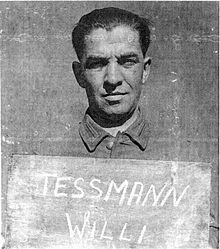Willi Tessmann
Willi Tessmann , full name Wilhelm Bernhard Tessmann (born January 15, 1908 in Hamburg ; † January 29, 1948 in the Hameln prison ) was a German police officer and at the time of National Socialism the commander of the Hamburg-Fuhlsbüttel police prison .
Life
Tessmann, son of a coachman, was involved in the Protestant church youth in his youth. After completing his school career, he completed an apprenticeship as a gardener, which he finished in 1925. He then worked as a gardener until he became unemployed at the end of September 1933 for operational reasons. Tessmann was politically active in the Young German Order , to which he belonged from 1925 to 1930. On May 1, 1932, he joined the NSDAP and the Schutzstaffel (SS).
Tessmann was engaged to Lieselotte, née Cohrs. The couple married in October 1935 and they had seven children.
time of the nationalsocialism
In February 1934, through his father-in-law's mediation, he got a job with the Hamburg police force. After a course lasting several weeks, Tessmann was employed by the Gestapo in September 1934 as a guard in the Fuhlsbüttel concentration camp . From 1937 Tessmann worked as a teletype operator for the Gestapo in Hamburg and from 1938 in the Secret State Police Office in Berlin, where he completed a police course. From 1940 he was again employed in the Hamburg-Fuhlsbüttel police prison, where he became deputy to the local commandant Johannes Rode in April 1943 and succeeded Rode as commandant in November 1943. Tessmann's deputy was Hans Stange.
Tessmann is said to have brought prisoners into solitary confinement if they had not confessed in accordance with the Gestapo. Several prisoners committed due to solitary confinement and torture suicide . He also mistreated prisoners and participated in executions that were carried out under his command.
Shortly before the liberation of Hamburg by the British troops, on April 15, 1945, Tessmann ordered the “evacuation” of the Fuhlsbüttler prisoners to the Nordmark labor education camp in Kiel-Hassee . Tessmann instructed the guards accompanying the death march to shoot weakened prisoners or those who were fleeing. On May 3, 1945, Tessmann went from Hamburg to Ipstedt near Schleswig , where he joined a battalion of the Wehrmacht , which disintegrated five days later.
Postwar Period, Trials and Death Sentence
After the end of the war he hired himself out on a farm near Heide and, as an alleged former Wehrmacht soldier, was no longer bothered by the British military authorities . On July 27, 1945, he lived again with his family in Hamburg-Langenhorn . Following a complaint from a neighbor, Tessmann was arrested on July 29, 1945 by members of the British military police and sent to the Hamburg remand prison. After several interrogations, he was transferred to the Neuengamme internment camp , where he was able to contact former SS and police colleagues who had been imprisoned. Tessmann was charged in two Curiohaus trials on the crime complex in the Hamburg-Fuhlsbüttel police prison. In both trials he was on trial with other defendants.
“During my service there were about 10 evacuations to Neuengamme for executions. Teßmann took part in these shootings. I don't know the nationality of these evacuated prisoners, except in one case where there were about 20 to 30 Eastern workers. These came from Schirrmeier's station. I particularly remember this case because Teßmann gave me the order to take part in this shooting. I refused and security guard Rusche got the order, but he also refused. "
Tessmann was sentenced to seven years in prison on August 6, 1947 for the execution of Soviet female forced laborers . On September 24, 1947, he was sentenced to death for mistreatment, the shooting of eleven Poles and his responsibility for the death march , and on January 29, 1948 he was executed in Hameln prison .
literature
- Christl Wickert : Willi Tessmann - Commander of the Hamburg-Fuhlsbüttel Police Prison . In: Klaus-Michael Mallmann & Gerhard Paul : Careers of violence. National Socialist perpetrator biographies. WBG , Darmstadt 2004, ISBN 3-534-16654-X .
- Gertrud Meyer : Night over Hamburg. Reports and documents 1933-1945. Library of Resistance, Röderberg-Verlag, Frankfurt am Main 1971.
Web link
- Uwe Fentsahm: The “evacuation march” from Hamburg-Fuhlsbüttel to Kiel-Hassee (April 12-15, 1945) (PDF; 2.1 MB). This article first appeared in Informations zur Schleswig-Holsteinische Zeitgeschichte (Kiel) No. 44. October 2004. pp. 66–105.
Individual evidence
- ↑ Christl Wickert: Willi Tessmann - Commander of the Hamburg-Fuhlsbüttel Police Prison , Darmstadt 2004, p. 231
- ^ Christl Wickert: Willi Tessmann - Commander of the Hamburg-Fuhlsbüttel Police Prison , Darmstadt 2004, p. 232
- ^ Christl Wickert: Willi Tessmann - Commander of the Hamburg-Fuhlsbüttel Police Prison , Darmstadt 2004, p. 232f.
- ↑ Uwe Fentsahm: The "Evacuation March" from Hamburg-Fuhlsbüttel to Kiel-Hassee (April 12-15, 1945) (PDF; 2.1 MB), p. 142
- ^ Christl Wickert: Willi Tessmann - Commander of the Hamburg-Fuhlsbüttel Police Prison , Darmstadt 2004, p. 232, 234
- ↑ a b Christl Wickert: Willi Tessmann - Commander of the Hamburg-Fuhlsbüttel Police Prison , Darmstadt 2004, p. 233f.
- ↑ a b Christl Wickert: Willi Tessmann - Commander of the Hamburg-Fuhlsbüttel Police Prison , Darmstadt 2004, p. 234f.
- ↑ Quoted from Gertrud Meyer: Night over Hamburg. Reports and documents 1933-1945. Frankfurt am Main 1971, p. 132
| personal data | |
|---|---|
| SURNAME | Tessmann, Willi |
| ALTERNATIVE NAMES | Tessmann, Wilhelm Bernhard (full name) |
| BRIEF DESCRIPTION | German policeman and commander of the Hamburg-Fuhlsbüttel police prison |
| DATE OF BIRTH | January 15, 1908 |
| PLACE OF BIRTH | Hamburg |
| DATE OF DEATH | January 29, 1948 |
| Place of death | Hameln prison |
